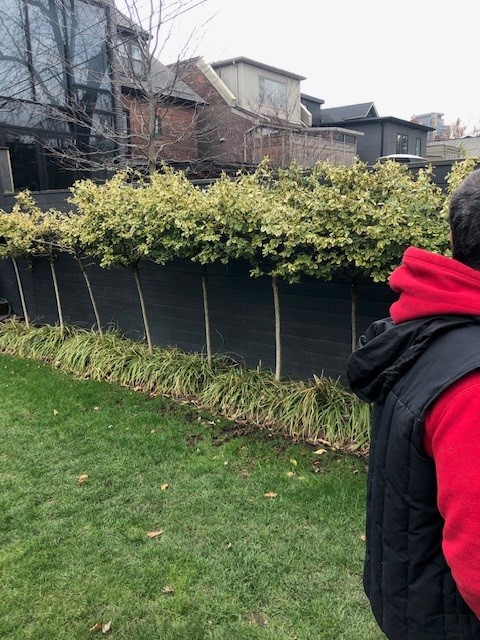
Hello and thank you in advance for your advice. I am wondering if it is possible to transplant the row of Euonymus Trees in the attached photo? The property they currently inhabited is in Toronto. The trees are approx. 5′ tall and receive full sun. They will be moved a few blocks away. Any advice on best approach, if possible, appreciated!
Thank you for contacting the Toronto Master Gardeners with your question about transplanting grafted euonymus (Euonymus fortunei) trees. In general, early spring and fall are the best time to transplant trees and shrubs, so it would be ok to go ahead in the next 2-3 weeks. Spring transplanting is done while the shrubs are still dormant and allows lots of time for growth over the spring/summer/fall. Fall transplanting is done with enough time to ensure trees and shrubs can begin to establish themselves in their new place before winter sets in (October in Toronto). If you need to transplant during the summer, ensuring your plants receive enough water will be key. Euonymus plants do well in many conditions, but it will be important to consider any major differences in sun exposure or soil moisture between the original and new locations and modify the plant’s care accordingly.
Before you dig in your new space, check for underground utilities. This can be easily done at Ontario One Call OntarioOneCall
Recommendations about transplanting trees and shrubs are evolving and incorporating new research findings. The information below draws specifically on resources from Landscape Ontario and Washington State University.
Begin by preparing the hole in the new planting space. A general recommendation is to create a hole 2-3 times the width of the tree’s root ball, and as deep as the root ball. The hole should be saucer shaped. Create a mound in the centre of the hole to support the root crown. Landscape Ontario’s Tree Planting Guide has a good diagram of what the hole should look like on page 43 Tree Planting Guide
Conserve the soil you remove when digging the hole to add back when planting. Unless the soil in your new location is of very poor quality, there is no need to add amendments. Research shows that trees and shrubs planted in the native soil of their planting location will establish roots better and grow more vigorously. You can read more about this here Soil Amendments
Now it’s time to dig up your trees. Begin by ensuring the trees are well-watered. This will make digging easier and help to ensure the trees don’t dry out during transplanting. Transplanting on a cooler, overcast day is optimal to protect your trees from drying out in the process. Whatever the weather conditions, protect your trees from prolonged exposure to direct sun or other harsh conditions while transplanting. There are a few guidelines to help you decide how much of the root ball to dig up. Suggestions include 2/3 the diameter of the branch spread and / or 12 inches for each inch of stem diameter. Dig around in a circle to a depth of about 12 inches and then angle downward underneath the plant. You may need to clip some straggling roots as you go. Lift the tree onto a tarp, some burlap or into a wheelbarrow to facilitate transportation to the new site.
Move your tree to the new site as quickly as possible. Once there, remove soil from the root ball by hand with a hose or in a tub of water to look for damaged or defective roots and prune them away. There will be very little soil left around the roots. This process is described in more detail here The myth of collapsing root balls
Now you can position your tree in the prepared hole. The shrub should sit at the same height in the new hole as it did in its original location. Ideally, the root flare (where the stem / trunk transitions to the root system), should be at ground level. Roots transplanted too deeply can suffocate or may circle the stem, called girdling, which will shorten the life of the tree. Planting above grade level will cause the shrub to try out faster, make it less stable and more prone to frost heaving.
Refill the hole with the native soil you dug out to create it. When hole is about 2/3 full, water well to help the soil settle and remove air pockets. Continue to fill the hole and water again. You can apply a high nitrogen, low phosphorus fertilizer (high first number, low second number) and then add 2-4 inches (5-10 cm) of organic mulch (e.g., wood chips) around the tree base but at least 6 inches (15 cm) away from the trunk/stem.
There is debate about whether newly planted trees need to be staked. This will depend on how exposed they are to windy conditions, and how stable the root system is. If you choose to stake your trees it should be for 1 year maximum and done loosely to prevent damage to the trunk.
Ensure your transplanted trees get adequate water over the coming year as they settle into their new spot. This is a key to successful and healthy growth. Deep infrequent (e.g., weekly) watering is better than brief frequent watering and can be adjusted based on weather conditions.
Best of luck with this project!
April 19, 2021

